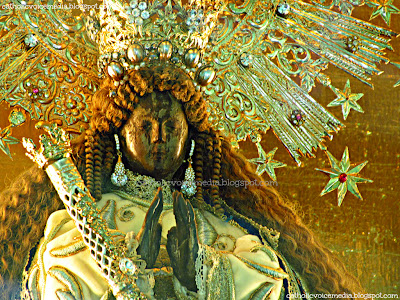Also known as "Our Lady of Guidance", the wooden statue is the oldest Marian image in the Philippines. It was my first time to visit the Nuestra Señora de Guia Parish Church in Ermita, Manila yesterday, March 25, 2013. Here's some information I gathered about this miraculous image.
 |
| Close up photo of the original image found in Nuestra Señora de Guia Parish Church in Ermita, Manila. |
The image of Nuestra Señora de Guia (literally translated as "Our Lady of Guidance" is the oldest among all those venerated in the Philippines. On May 19 1571 (Saturday). Miguel Lopez de Legaspi took possesion of Manila in honor of the King of Spain, Felipe II. On this occasion one of his soldiers roamed places and reached as far as the seashore (now the site of the Ermita Church) and witnessed the natives pagan worship to a beautiful statue of the Virgin Mary placed on top of trunk surrounded by pandan. From that day, according to Anales dela Cathedral de Manila, the Virgen de Guia began to shed the rays of charity i never so many miracles which she wrought in behalf of the people especially the navigators. It is in this light that she was given the title Guia (guide).
It was believed that it must been brought to the Philippines in 1521 by Magellan's own ships and was later sent by the Cebu native chiefs as a gift to one of the many rajahs in Manila in a Royal Decree dated August 9, 1578, the King of Spain declared Nuestra Señora de Guia as the "Sworn Patroness" of Manila by reason of the continual favors that she lavished on it. Also, the Ermita Church where the little statue stands is the historically the foremost amongst Marian shrines in the Philippines.
With the designation of 1954 as Marian year, Nuestra Señora de Guia took on added relevance. The reason was obvious: the Marian year was the centenary of the proclamation of the dogma of the Immaculate Conception and the Nuestra Senora is the first statue of the Immaculate Conception ever set eyes upon by Filipinos.
When the church was finished, the renowed image was transffered from the Cathedral to its new temple with solemn pomp and rejoiced that lasted for eight consecutive days.
On this event a loa (praise) was composed, dialogued in regular verses by three speakers, one representing the city of Manila, another the people of Ermita, and the third the guardian angel of the town.
According to several devotees, Our Lady of de Guia had shown abundant favors to the Filipinos, most especially navigators of the ships from Spain. Whenever a galleon was scheduled to sail for New Spain, the navigators would make a novena of solemn masses with the attendance of the Cabildo Eclesiastico alternately with the religious committees.
Similarly, when the galleons were delayed in coming, they carriedhe image in procession, from her temple in Ermita winding-tip in the Cathedral. This resulted in another solemn nine-day festival during which ships from New Spain would arrive safetly in spite of turbulent seas. They attribute the arrival of these vessels to the protection given by the Virgen de Guia.
Nobody seemed to know then, how this image came to these islands. No historian could trace its source. It could have not been brought by the Europeans who were here before the conquest. Others conjectured that it could be the patroness of a vessel that lost at sea and was cast accidentally to these islands by strong waves.
The image of De Guia is brown, about fifty centimeters tall including its pedestal. The lining of its dress on tunic is of dark red silk with white parallel strips. From the waistline to its tunic, it has kind of tapis similar to that worn by our Tagalog women
Text Source: http://nuestrasenoradeguia.com/home1.html































